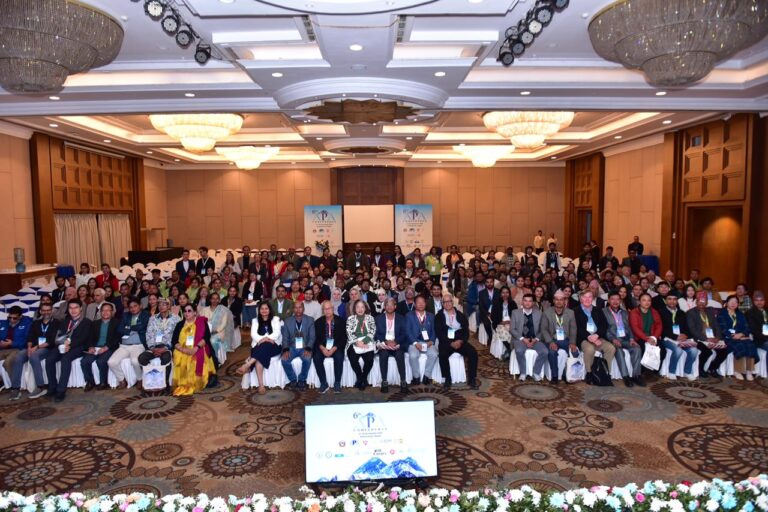The 6th Asian Population Association Conference (APAC 6), organized by the Central Department of Population Studies, Tribhuvan University, officially opened on 27 November and concluded on 30 November 2024, bringing together key policymakers, researchers, and international experts to discuss the pressing demographic issues of Asia. The inaugural session featured distinguished speakers including the Rt. Hon. Prime Minister K.P. Sharma Oli and Hon. Sher B. Deuba, Former Prime Minister of Nepal, along with senior representatives from academic institutions, government, and international organizations.
The conference explored the complex interplay between social, economic, and demographic factors, leveraging contemporary demographic data and analysis to address critical population challenges.
The conference featured 237 Oral Presentations and 186 Poster Presentations, spanning 17 Themes, along with 59 Oral Sessions (Plenary and Parallel) and 4 Poster Sessions. These presentations covered a wide range of issues related to population dynamics, such as aging populations, migration, gender equality, health disparities, and the implications of climate change on demographic trends. It aimed to foster collaborative discussions and provide innovative solutions to address the pressing demographic challenges in Asia, ultimately contributing to sustainable development efforts in this region.
The overall conference, encompassing oral and poster presentations, reflected on eight major components. These themes emphasized the interconnectedness of population dynamics with health, mobility, environment, and innovation, showcasing regional and global perspectives on addressing these critical issues.
East Asia’s Demographic Shifts and Their Impacts
East Asia, South Asia, and Southeast Asia are experiencing significant demographic shifts, including low fertility rates, increasing life expectancy, and evolving marriage patterns. These trends are leading to an “aged boom,” necessitating innovative policy responses. While birth promotion policies are being considered, the focus now should shift towards maximizing the potential of the aging population.
China’s one-child policy has created a “marriage squeeze,” delaying marriages due to societal and economic pressures on men. Urbanization is shown to reduce son preference in China. Marriage patterns are evolving, with rising remarriage rates influenced by factors like women’s education. In Indonesia, the concept of “halal love” reflects the integration of religiosity and autonomy in courtship. Marriage patterns and fertility decisions are influenced by factors like education, gender attitudes, and economic conditions, leading to delayed marriages in countries like Iran and China.
In Iran, education and egalitarian gender attitudes are contributing to later marriages. Higher education is linked to increased childlessness, particularly among women balancing work and family.
While Japan’s rise in age-related deaths with senility has raised concerns in gerontology.
Addressing Gender Disparities and Improving Health Outcomes in Asia
Gender-specific interventions are crucial for improving maternal and child health and addressing issues like stunting, anemia, and low birth weight. Enhancing the quality of private health services, particularly in reproductive health, is essential. Contraceptive decisions needed to be more family-centered. Migration is also seen to have significant mental health impacts, varying by ethno-caste and gender. Addressing tuberculosis underreporting, stigma, and multimorbidity requires gender-sensitive and inclusive policies. Gender disparities in COPD mortality and disability burden highlighted the need for targeted health policies.
Climate Change and Societal Shifts on Vulnerable Populations
Climate change worsened food insecurity and health risks, particularly for the population engaged in agriculture and those living in coastal areas who are vulnerable to cyclones. In South Korea, the aging population, especially those over 85, faced increased vulnerability to extreme heat waves, particularly in metropolitan areas. Despite initiatives like India’s ‘Swachh Bharat Mission’, rural areas saw rising open garbage disposal, negatively impacting public health.
East Asia’s aging population required policy adaptations that is apparent from Thailand’s birth promotion policies failing to address population decline. Marriage patterns and fertility decisions were influenced by factors like education, gender attitudes, and economic conditions, leading to delayed marriages in countries like Iran and China. Meanwhile, child nutrition in India remained a challenge, with crop diversity reducing stunting and underweight but not addressing wasting.
Empowering Women through Education and Gender-Responsive Policies in South Asia
Policies empowered women through education, vocational training, and gender equality in work and family roles. Despite awareness, girl trafficking in Nepal’s border regions persisted. Gender, societal norms, culture, and poverty influenced health, contraceptive use, disease prevention, mental health, education, and empowerment, requiring culturally sensitive interventions. Rural women in India are more likely to be insured with higher public insurance coverage. Vocational courses transformed out-of-school girls’ lives, enhancing self-efficacy and reshaping gender roles. Addressing the dual burdens and stigmas faced by single women in the workforce is key to promoting gender equity and labor participation.
Enhancing Demographic Analysis through Digital Technologies and Automation
APIs (Application Programming Interfaces) can automate analysis protocols by applying them directly to datasets, enabling the generation of results at predetermined intervals. Visual outputs, such as heatmaps are easily interpretable simplifying training of managers in data analysis and enhancing efficiency.
Machine learning models like Random Forest and Decision Tree offer high accuracy in demographic analysis, identifying key social, behavioral, and demographic determinants. This facilitates more informed decision-making and effective policy development.
Data and Demographics in Asia
Data quality and quantity in Asia’s central statistical bureaus have declined over the past 15 years, impacting decision-making. The rise of digital nomads is reshaping migration and labor markets, contributing to developing economies but facing challenges in taxation, stability, and integration. Education and policy investments were key to harnessing human capital, achieving demographic dividends, and ensuring sustainable development.
Migration and Labor Migration in South Asi
Migration was shaped by cultural norms, care needs, and systemic challenges. Temporary childbirth migration (TCM) highlighted the need for supportive systems for women, while labor migration policies had to ensure access to education, healthcare, social security, and protection from harm. Depression in elderly Indian migrants and the exploitation of workers under the Gulf’s ‘Kafala’ system emphasized the need for psychological support and labor reforms. Parental migration impacts children’s mental health, with higher risks for internal migrants’ children. In Japan, return migration supported parent and child co-residence, influenced by family roles and life stages, stressing the need for tailored policies and support systems.
Population Policy Challenges and Recommendations for Asia
The overall presentations in all sessions emphasized critical areas for policy reform and development across Asia. Key topics included migrant rights, labor conditions, reproductive health, and gender-sensitive policies. The discussions also highlighted the need for family support for migrant workers, the importance of sub-national population projections, and the growing demand for urban resilience in rapidly expanding cities.
Throughout the sessions, a strong emphasis was placed on the necessity of data-driven approaches, inclusive policymaking, and targeted interventions to address the region’s complex demographic and socio-economic challenges effectively.
Closing Remarks
The 6th APA Conference provided a vital platform for dialogue and collaboration on the most pressing demographic challenges facing Asia. Minister Sharat Singh Bhandari’s remarks underscored the government’s commitment to improving the lives of Nepali migrant workers by enhancing their legal protection, access to healthcare, and skills development. His emphasis on creating a sustainable and protective environment for migrant workers reflected Nepal’s recognition of their invaluable contributions to the economy. The Conference served as a crucial platform for the exchange of ideas and solutions to address the region’s most pressing demographic challenges. The event brought together leaders, researchers, and policymakers to collaborate on strategies that would ensure a sustainable, inclusive future for Asia.
Yogendra Bahadur Gurung
Chair of National Organizing Committee
6th APA Conference 2024
Head of Department
Central Department of Population Studies



 About Us
About Us
Comment